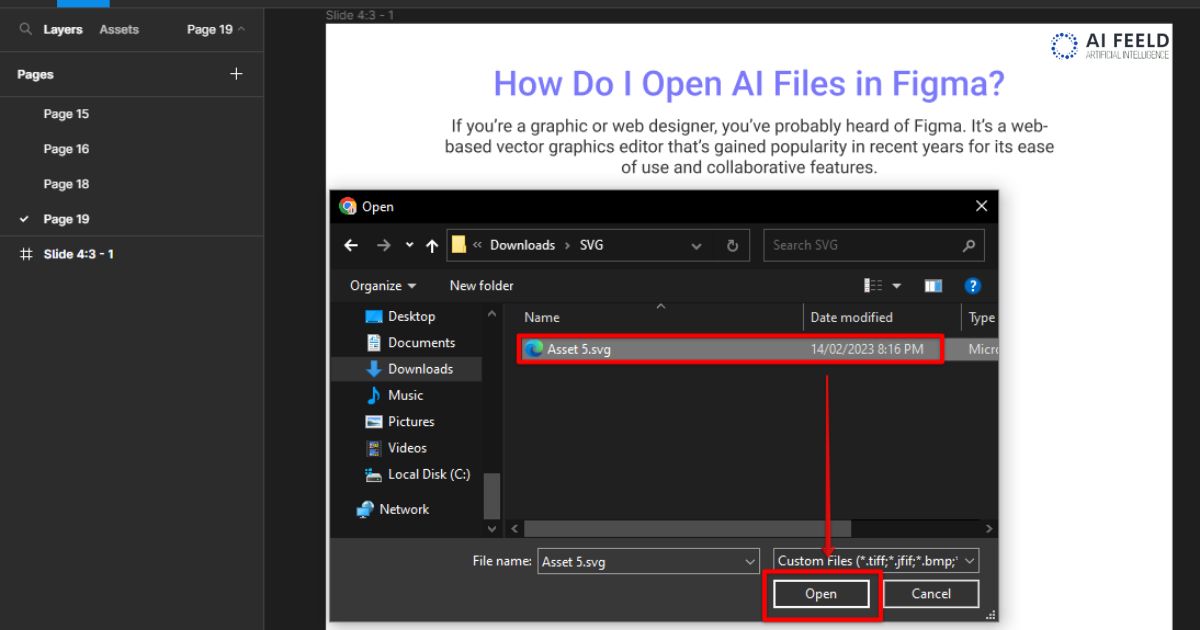Figma, an increasingly popular interface design tool, offers a comprehensive platform for creative individuals to craft visually stunning designs and prototypes collaboratively. One common query among designers is how to open AI files (Adobe Illustrator files) in Figma for further editing or collaboration. In this comprehensive guide, we’ll explore the step by step process, enabling you to seamlessly import AI files into Figma.
Understanding AI Files and Figma
What are AI Files?
AI files are proprietary file formats created by Adobe Illustrator, a powerful vector graphics editor. These files are widely used for creating logos, illustrations, and various graphic elements due to their scalability without loss of quality.
Introduction to Figma
Figma, a cloud based design tool, allows real time collaboration and design creation with its intuitive interface. Its versatility has made it a popular choice among designers and teams working on various projects.
Steps to Open AI Files in Figma
Exporting AI Files for Figma
1. Save as SVG: In Adobe Illustrator, open the AI file you wish to transfer to Figma. Go to the File menu, select Save As, and choose the SVG (Scalable Vector Graphics) format. This format ensures compatibility with Figma.
2. Clean up and Organize: Before exporting, ensure your layers are well organized in Illustrator. Named layers and groups will facilitate a smoother import into Figma.
Importing AI Files into Figma
Open Figma and Create a New File: Log in to your Figma account or sign up for a new one. Create a new file where you want to import the AI design.
Use the Import Function: Within Figma, go to the toolbar and click on the File option. Choose Import and select the SVG file you saved from Adobe Illustrator. Figma will convert and open the SVG file in the canvas.
Navigating AI Designs in Figma
Understanding the Converted Design
The imported design might have different elements organized into layers and groups. Figma allows you to edit, manipulate, and reorganize these elements for further enhancements or collaborative work.
Leveraging Figma’s Tools
1. Editing Tools: Figma provides a range of editing tools allowing modifications to the imported design—resizing, color adjustments, and layer management, among others.
2. Collaboration Features: Utilize Figma’s collaborative features to work with team members on the imported AI design. This fosters a seamless workflow and creative exchange.
Tips and Best Practices
Regular Backups: Save iterations of your work in Figma to prevent data loss.
Naming Conventions: Use clear and concise names for layers and elements to maintain organization.
Version History: Take advantage of Figma’s version history feature to track changes made during the design process.
Table: Pros and Cons of Importing AI Files into Figma
| Pros | Cons |
| Seamless transition for editing | Minor variations in complex AI designs |
| Collaborative features | Potential loss of some Illustrator effects |
| Scalability without loss of quality | Adjustment of certain design elements |
Exploring AI File Features in Figma
Leveraging Figma’s Vector Editing Capabilities
Upon importing an AI file into Figma, the design components are presented as vectors, allowing for seamless editing. Figma’s vector editing tools enable modifications such as resizing, reshaping, and tweaking the design elements with precision.
Utilizing the Pen tool, users can add, remove, or adjust anchor points in vector paths. This feature proves beneficial for refining intricate details within the design. Furthermore, Figma offers alignment and distribution tools to ensure consistency and precision in the design layout.
Managing Layers and Groups in Figma

The organizational structure of the imported AI design might undergo minor changes during the conversion. Layers and groups in Figma play a crucial role in maintaining the integrity of the design. Users can easily rename, rearrange, and group elements, facilitating a more structured and manageable design canvas.
Figma’s layer panel enables users to access and manipulate individual design components, making it easier to target specific elements for modifications or enhancements. This feature simplifies the design process, especially when working on complex AI designs with multiple elements.
Advanced Techniques for AI Files in Figma
Using Plugins for Enhanced Functionality
Figma’s ecosystem is enriched with plugins that offer extended functionalities. There are specific plugins designed to optimize the import and editing of AI files within Figma. For instance, plugins for batch renaming layers or organizing imported elements can significantly streamline the design workflow.
Mastering Collaboration in Figma
Collaboration is a hallmark feature of Figma. Once an AI file is imported, multiple team members can concurrently work on the design in real time. Comments, suggestions, and changes can be made instantly, fostering a dynamic environment for creativity and teamwork.
Troubleshooting
Addressing Import Issues
Some complex AI file features, like certain effects or complex gradients, might not translate perfectly during the import into Figma. In such cases, workarounds or alternative design approaches may be required.
Additionally, if there are any compatibility issues during the import process, ensuring the AI file is saved in a simplified manner—avoiding overly complex effects or gradients—can enhance the import’s success rate.
FAQs
Are all AI file elements compatible with Figma?
While Figma supports most AI file elements, complex effects or certain unsupported features might not import perfectly.
How can I maintain the quality of the design during the import process?
Ensuring the AI file is well organized with proper naming conventions and fewer complex effects can aid in maintaining design quality.
Can I export my design back to AI format from Figma?
Figma primarily exports designs in SVG, PNG, or PDF formats. There isn’t a direct export feature to AI format, but you can save your designs in these other formats for later AI usage.
Conclusion
Opening AI files in Figma streamlines the design workflow, allowing for easy collaboration and editing within a powerful interface. By following these steps, designers can seamlessly transition their Adobe Illustrator creations into Figma, harnessing the best of both platforms.
In conclusion, the integration of AI files into Figma provides a bridge between two powerful design tools, offering the best of both worlds for designers and creative teams.
Remember, the success of this process largely depends on the organization of your AI files before importing them into Figma. By following the steps and leveraging Figma’s tools, you can enhance, edit, and collaborate on your AI designs seamlessly.











